 enEnglisch
enEnglischThe cultural framework
Renaissance: harpsichord and clavichord
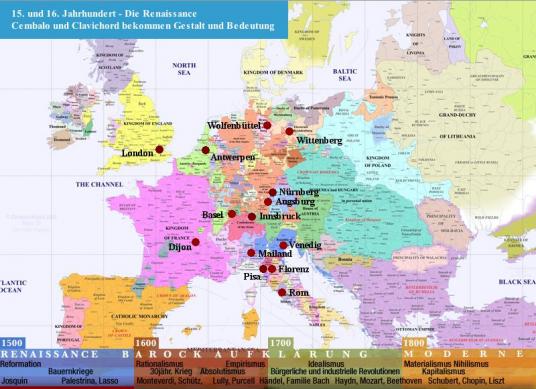
Antwerp
Flemish harpsichord production focussed on the port city of Antwerp (and in particular the Ruckers family). During the 16th century several specific harpsichord types emerged, In opposition to the Italian tradition the Flemish workshops concentrated on making virginals of a specific solid construction which allowed to be exported in great numbers to other European countries. Their sound is comparatively rich and voluminous, the instruments rugged as well as decorative and appreciated for their appearance.
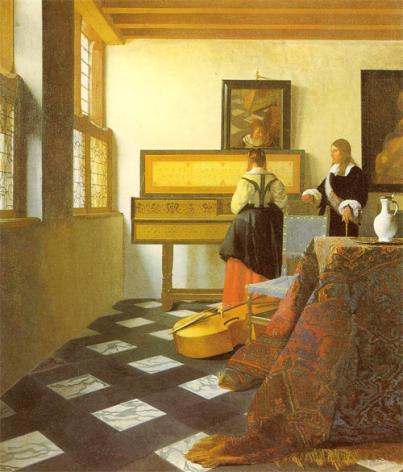
"Die Musikstunde", ca 1662-65, Royal Collection,
St. James' Palace, London
Augsburg - Nuremberg - Innsbruck
Augsburg and Innsbruck here represent the many cultural centres of the Holy Roman Empire where keyboard music flourished at a large scale. The most important early keyboard manuscripts originated in the southern German regions, so did the greatest virtuosos of the age like Conrad Paumann or later Paul Hofhaimer. Paumann was born in Nürnberg and later moved to München where he was buried. Hofhaimer was imperial court organist and worked in Augsburg, Innsbruck and many other places. The organs he cooperated in planning in Augsburg, St. Anna (destroyed in 1944) and Innsbruck, Hofkirche (extant) still remind of his importance. In their age the repertoire for all keyboard instruments is more or less identical, there is hardly any difference between organ and stringed keyboard compositions.
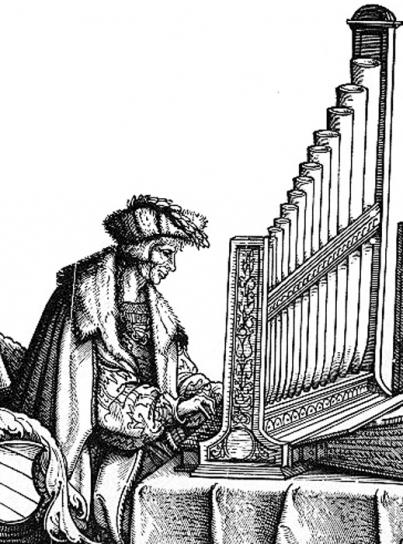
Basel
The first treatise about musical instruments in a vernacular was printed in Basel in 1511, Musica getutscht („germanised“) by Sebastian Virdung, with woodcuts by Urs Graf. Common interest in musical instruments and their music has obviously grown to such an extent that from now on it is described no longer in scholarly Latin.
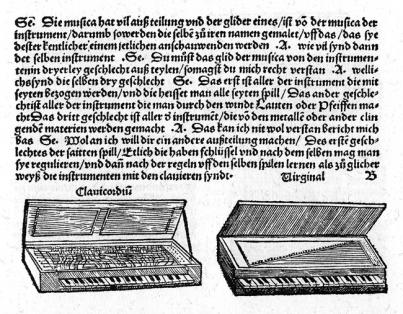
Dijon
C.1440:
The scholar Henri Arnaut of Zwolle in c1440 wrote a study De mensura fistularum (“About the measures of organ pipes”), the first treatise dealing about the construction of musical instruments focussing on organ but also explaining a multitude of other contemporary instruments like clavichord, harpsichord, „dulce melos“
(a mysterious keyboard instrument with hammers striking strings, of which this is the only source, more than two centuries before Cristofori!) and lute. For the first time he demostrated the geometric principles which - modified - are used in designing and constructing musical instruments.
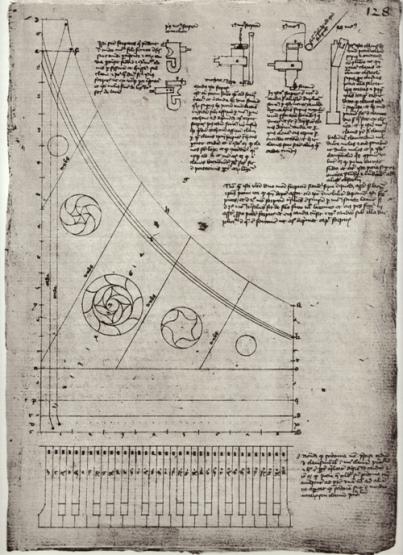
Florence-Milano-Roma-Venezia
A first climax in harpsichord making can be watched in Italy establishing a distinct "school tradition" producing a defined type of harpsichord with characteristic features. Italian harpsichord have thin walls and a quick but "brittle" sound giving the first satisfying samples. Harpsichord making in other countries followed their ideas or developed contrasting concepts.

London
In England music under Tudor reign flourished, and their courtly style soon was imitated by prosperous nobility and gentry offering solid existences for professional musicians spreading over towns, cathedrals, and country manors. The keyboard music by composers like John Bull, William Byrd and others created the term virginalists (including not only the widespread Flemish type virginal but all keyboard instruments including the organ), a climactic point of keyboard music in late Renaissance and during the 17th century influencing keyboard music in other northern European countries.
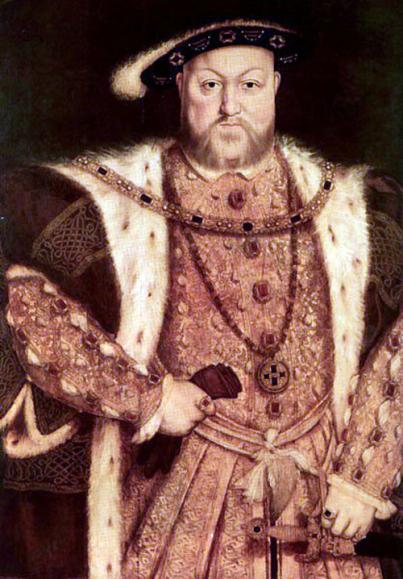
Pisa
Leonardo da Vinci, painter, architect , inventor
... designed around 1500, among many other plans, some constructions of musical instruments like a "Viola
organizzata“ (a mechanism for a bowed keyboard instrument), a trumpet with a keyboard, or a beating machine for drums.
Unlike his desings for vehicles of flying machines which have been indeed built and tested for their functionability over the 19th and 20th centuries, some of his musical technical ideas are stil awaiting to be tested.
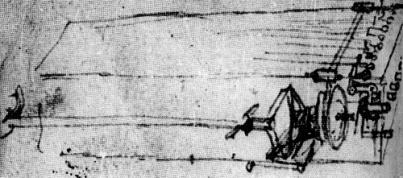
Wittenberg
Luther's publisher Georg Rhaw in Wittenberg in 1529 also published Musica instrumentalis deudsch by the Magdeburg musical director Martin Agricola. Referring to Virdung's book published in Basel (and copying Graf's woodcuts) Agricola adds more informations and gives an insight in the rapid developments of instrumental music in this time. It is the first book of this kind meant to be used in schools.
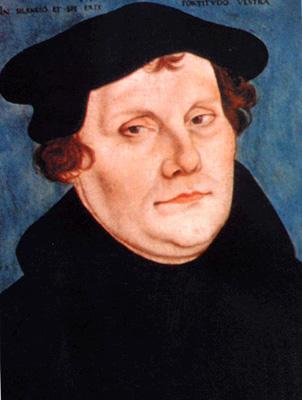
Wolfenbuettel
In 1619 the second volume of Syntagma Musicum with the addition De Organographia (Decription of the organ [including other instruments]“ by Michael Praetorius was published. Praetorius described the instruments of his time with an emphasis on the new creations of the late Renaissance. His extensiveness makes it a valuable source of informations beyond comparison.
(Musical posterity only laments one thing: He probably knew where and how the violin emerged. But he only wrote „Und demnach dieselbige
jedermänniglichen bekandt, ist darvon ... etwas mehr anzudeuten und zu
schreiben unnötig.“ (" Since this is only too well known by everyone ... it is needless to hint and write more"); If he only had "hinted" something ... what was then known to everyone, nobody knows any longer today.
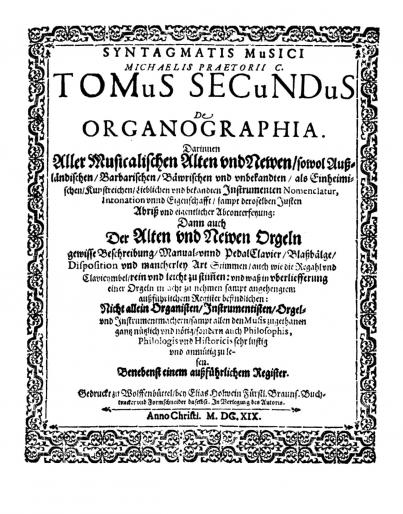
Michael Praetorius: Syntagma Musicum II. De Organographia, Wolfenbüttel 1619
Baroque flourishing: the Harpsichord
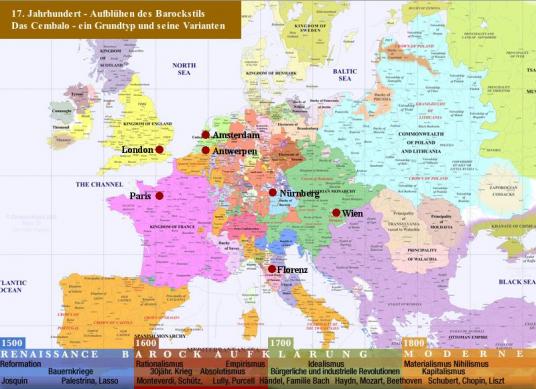
Amsterdam
In 1648 the protestant northern provinces of the Netherlands gained their independece but the catholic southern provinces remained under the rule of the spanish Habsburgs (modern Belgium). The kingdom of the Netherlands ruled by the Oranien-Nassau dynasty soon grows to one of the wealthiest states of Europe by the busy overseas trades with Asia and America and the dutch cities esp Amsterdam soon overshadow their southern neighbours in Flanders like Antwerp, Brussels or Bruges. This includes a "Golden Era" of the Arts including painting and horticulture- but the music falls into decline.
The important exception is manifest in Jan
Pieterszoon Sweelinck, organist of the Oude Kerk of Amsterdam, one of the most important keyboard composers of the late 16th century; but apart from his compositions his utmost importance is as a (well paid obviously) teacher of the most important dutch and german keyboard composers of the 17th century.
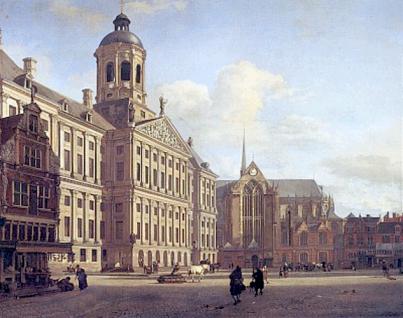
Antwerp
The southern Spanish Netherlands remained a region of unrest, fighting for independence from Spain and supported by France, England, or the independent northern provinces – in ever-changing coalitions – to weaken each other and to gain control of this rich province of the Hapsburg empire.
The flourishing musical culture of this region influencing the whole of Europe in the previous centuries suffers under the permanent unrests, uprisings and military expeditions.The Ruckers (and Couchet) workshop in Antwerp and the Dulcken family carries on the harpsichord tradition well into the 18th century, but the economic situation in Antwerp is in steady decline.
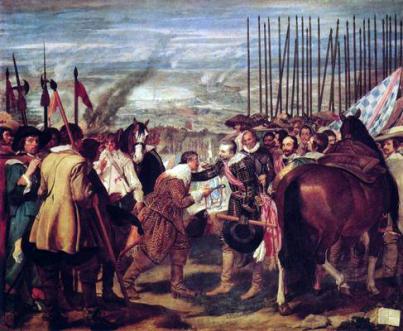
Florence
The small city-states of northern Italy, with their ruling noble families like the Medici, Este, Sforza, or Gonzaga, are small but often very wealthy due to trade. The competition between them (as well as with the neighboring republics of Venice and Genoa and the Papal States) and attempts from outside to bring them under French, German (nominally they were partly part of the Holy Roman Empire), or Spanish control have shaped their history and culture for centuries. However, their decline slowly begins in the 17th century. The Mediterranean trade, which had made states like Venice rich, loses more and more significance—the Ottoman Empire dominates the southern and eastern Mediterranean coasts, and the expeditions of the Portuguese and Spanish to India (hence the naming of the Caribbean islands as the West Indies) and East Asia shift European (American and) Eastern trade to the sea route across the Atlantic, from which the fleets of the Italians are practically excluded. Furthermore, the old transalpine trade relationships also lose importance as a terrible war rages in Northern Europe for decades.
Yet music flourishes: opera and oratorio, church music, and courtly musical life serve as models for all of Europe; a stay or even an education in Italy is the final refinement of skills for many aspiring young composers from the North. During this period, Italy acquires its reputation as the premier land of music in Europe.

London
The 17th century is not only a turbulent and warlike time on the European mainland but also on the British Isles. Although England had already fought its major religious conflicts internally under the Tudors—Henry VIII, Mary, and Elizabeth—in the second half of the 16th century (no less cruelly than in other countries), with the deposition (and beheading in 1649) of Charles I, an era of the most brutal civil war in England and Ireland begins. The period following Cromwell's victory, the Commonwealth era, and the dominance of Puritan-influenced beliefs is outwardly a very music-hostile epoch: Church music is more or less undesirable, and public musical life practically does not exist. Making music becomes a private (and almost secretly practiced) indulgence on the borderline of vice. In this situation, domestic playing on a keyboard instrument remains one of the few ways to enjoy music.
This only changes again with the accession of Charles II in 1661; although succession conflicts repeatedly break out after his death, cultural life stabilizes under his rule. However, the later judgment of England as a country without music, despite some notable exceptions like Henry Purcell, has its roots in the events of the 17th century.
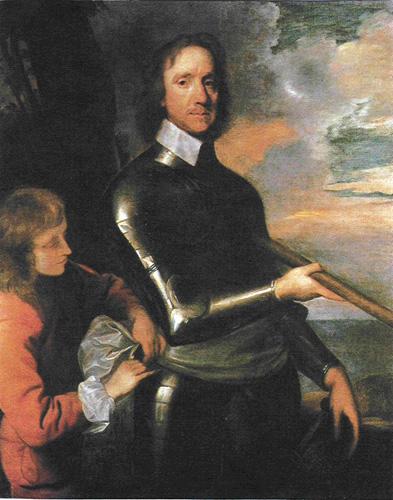
Nuremberg
Like most German countries and cities, Nuremberg was heavily affected by the Thirty Years' War. The depopulation—between 1618 and 1648, more than a third of the inhabitants in some areas lost their lives—left Central Europe recovering only very slowly. And particularly the old trade metropolises like Nuremberg and Augsburg never regained their former importance.
Nevertheless, in the 17th and 18th centuries, Nuremberg played a significant role in cultural life once more. Composers like Pachelbel and his student Leffloth attest to the high level of keyboard artistry that flourished there. And an important component of all pianos came from Nuremberg for centuries: the strings. The art of metal wire drawing was significantly improved in Nuremberg (with the invention of the mechanical drawing bench around the turn of the 16th century) and was fundamental for the use of strings made from brass and other metals in pianos.
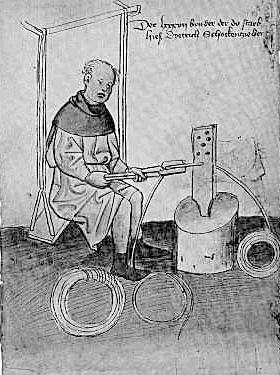
Paris
France emerged from the Thirty Years' War significantly strengthened. The absolute French monarchy under the Sun King Louis XIV is regarded in many respects as a model for all of Europe, also in many cultural areas. Just as many small European princes subsequently had their own miniature Versailles built, they emulated the French court in all aspects of courtly representation. Thus, soon, court orchestras based on Lully's model in Paris emerged in many residences across Europe.
Paris also set aesthetic standards in the field of music for keyboard instruments. The model of the harpsichord suites by the Couperin family had an influence that extended well into the following century. From the mid-17th century onward, there were two prevailing styles in music, the Italian and the French; and in the field of music for keyboard instruments, everywhere except in Italy, only one. Consequently, composers such as Purcell, Handel, Bach, and others generally composed for the harpsichord following French stylistic principles.
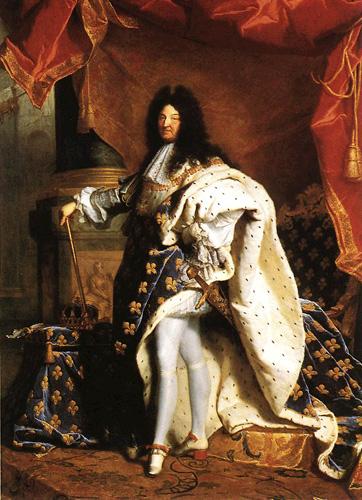
Vienna
The capital of the mighty Habsburg Empire, in which (before the division of the House of Habsburg into a Spanish and an Austrian line) the sun never sets, itself was threatened for centuries by the Ottoman Turks, whose conquests in Southeast Europe ended multiple times just at the gates of Vienna (most recently in 1683). In the 17th century, Vienna became a cultural center for the part of Europe that remained Catholic.
The significance of Vienna as the home of major piano composers did not begin with the Viennese Classical period. In the 17th century, one of the most important keyboard composers, Johann Jacob Froberger, lived and worked here. He integrated the traditions of Italian (Frescobaldi) and German (Sweelinck and his pupils) keyboard composition and passed them on to his successors in Vienna (Poglietti, Kerll, and others).

A multitude of ideas: pianoforte emerging
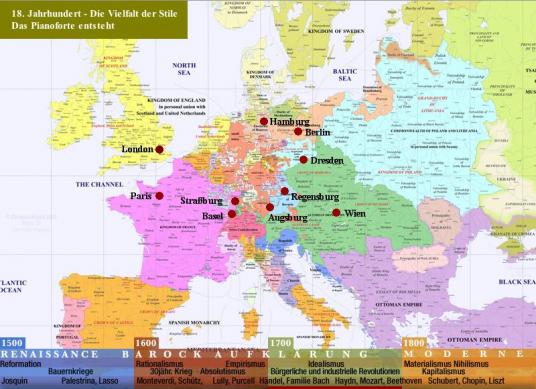
Augsburg
After the 30 years' war the Imperial City Augsburg received a constitution demanding religious parity of Catholics and Protestants: Every public office was doubled to be maintained by one representative of each denominations, whether mayor or scribe. A settling of a craftsman is a relatively complex procedure with numerous testimonies and attestation and statements from both sides, but on the other side this also offers a basis of contact and exchange between the strictly separated communities.
Johann Andreas Stein after his move to Augsburg c.1750 soon becomes a major attraction or the town, Almost any musician of rank is keen to pay a visit him when passing Augsburg, so Mozart in 1777, Beethoven probably 10 years after. Many disciples of him transfer the piano manufacture to other towns, his daughter Nannette moves to the upcoming metropolis of piano Vienna.
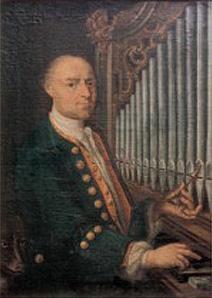
Basel
A family portrait in a civil patrician salon Basel in late 18th century gets depicted by the painterJohann Jacob Burckhardt of 1775. Particularly remarkable is the situation on the right: Music is an activity of the grown children. Daughter playing keyboard instrument (here a typical contemporary oblique spinet), the son tuning his violin. The scenery is a metaphor for the future „being in tune“ with a marriage consort, music making one of socially acceptable situations for future spouses to meet and children should be educated for.
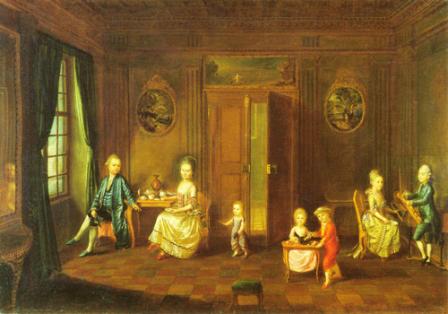
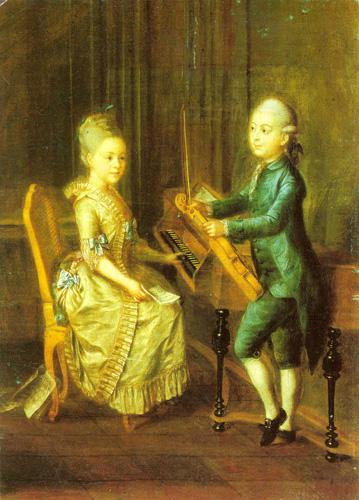
Familienbildnis Peter Burckhardt-Forcart, dat. 1775, Maler: Joseph Johann Kauffmann, Basel
Berlin - Hamburg
German harpsichord building before 1700 left only few traces, probably a consequence of the 30 years' war. Producing clavichords and harpsichords traditionally was a side business of organ builders, even more so at times when repearing and building new organs did not provide enough income. Only in a few prospering cities specialised workshops focussing on harpsichords could manage, as in the Prussian capital Berlin, or the port city Hamburg exporting to the Scandivian and Baltic regions. The harpsichords by the Haas/Hass family, Fleischer and Christian Zell differ considerably by their unique constructions, decoration and disposition from the rest of German instruments of the time and reveal the orientation towards a wealty clientele.
In Berlin the admiration for music of some Hohenzollern family members (particularly Friedrich II and his sister princess Anna
Amalie of Prussia) attracted the most prominent composers who represent the stylistic changes in mid-18th c. music: the brothers Graun, the Benda family, Carl Philipp Emanuel Bach as court harpsichordist or the flutist Johann Joachim Quantz, the teacher of Friedrich. In response also the instrument building flourished and achieved top standard, whether the flutes by Kirst
or the harpsichords of Mietke, no less prominent in the Berlin and Potsdam castles than the pianos of Silbermann.
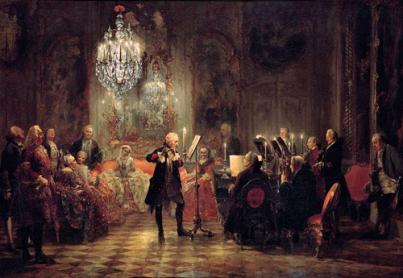
Dresden
Dresden is remodelled under the reign of Augustus II the Strong prince-elector of Saxony and king of Poland tbe renowned as one of the most excellent cities in Europe. The famous baroque ceremonial buildings corresponded in excellence in the quality of the Dresden court orchestra than maybe the best in Europe. But Saxony's brilliance did not last. The Seven years' war ruined the country but even the decline of Saxony had severe cultural consequences.
Gottfried Silbermann who worked during these glorious times is not only one of the most excellent organ makers of the 18th century (main works: Dresden Frauenkirche 1732-36, sadly not reconstructed during rebuilding, and Hofkirche 1750-54, completed posthumously; Mozart commented: „Es sind über die Maßen herrliche Instrumente“ - excellent beyond measure), but also by his re-constructing of the pianofortes by Cristofori one of the key figures for the spreading and slow diffusion of the piano. His pianos were especially appreciated in Berlin, he delivered about 15 to Frederic II for every of his castles in (the majority destroyed in WWII). But even more relevant for the piano success story were the numerous disciples of Silbermann's like the „12 apostles“ emigrating to London (and among them eg Johann Christoph Zumpe), the co-founders of english piano making.
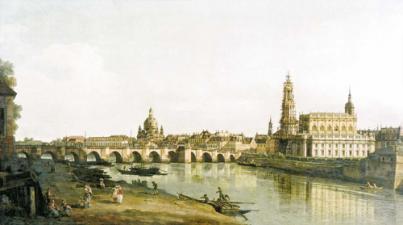
London
The accession of the House of Hannover in 1714 marked the end of dynastic conflicts in Great Britain (the unfortunate episode of sad „Bonnie Prince Charlie“ 1745 aside) and the beginning of a rapid development of the United Kingdom's advance to world power - despite the loss of 13 north american colonies 1776.
London becomes a world metropolis – and the town paying the highest salaries for musicians. Händel's example was followed by numerous european musicians like Johann Christian Bach and Joseph Haydn – a second travel of Mozart failed because of his early death. However, english musicians were a rarity in London – the profession of a musician had a bad reputation. For european virtuosos a flourishing musical culture offered best conditions thanks to an immigrant-dominated „music industry“ with venues concert managers, publishers and instrument makers of all kinds.
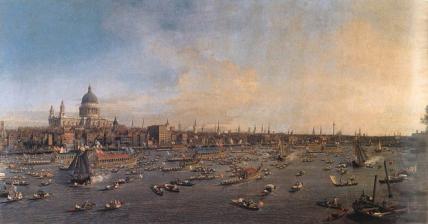
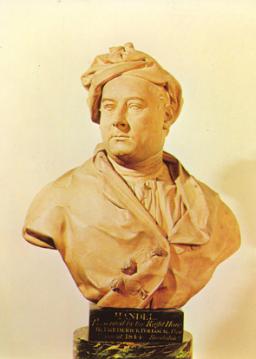
Regensburg-Ratisbon
The protestant Imperial city amidst catholic Bavaria is from 1663 to 1806 seat of the Perpetual Diet of the Holy Roman Empire, a convention of the territories and monarchs within the empire, their ambassadors taking temporary or permanent quarters within town.
This encouraged the establishments of keyboard making workshops. The most important of these the workshop of „Späth und Schmahl“ are still well known for the tangent pianos. Regensburg is one of the earliest keyboard manufacturing centres in the modern sense focussing on export. Up to the early 19th century the Regensburg makers exported their Instruments to Italy, France, Russia, America, the Baltic and the other German speaking territories.
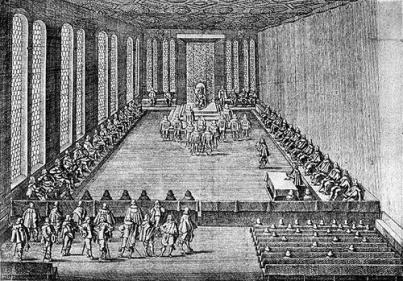
Straßburg
For Straßburg 1648 is a year of grave change: the former Imperial city becomes part of France at the end of the 30 years' war. Town and country become the more a centre of mutual cultural exchange across the Rhine. Since Straßburg joined the reformation early the town is a focal point for protestants on both banks of the Rhine.
One name shines out in the 18th century representing the close link of German and French musical culture in the Alsace: Silbermann. The founder of this organ makers' dynasty, Andreas S. of Kleinbobritsch in Saxony, moves to Straßburg around 1700. From then on to far in the 19th centuy his specific style shapes the still famous alsatian organs of that time. More relevant for piano making, however, are his younger brother Gottfried (-> Dresden) and his son Johann Andreas S.; although they all also produced harpsichords and clavichords Gottfried Silbermann's attempt to imitate Cristofori's „Gravecembalo col piano e forte“ is the trigger for piano production north of the alps.
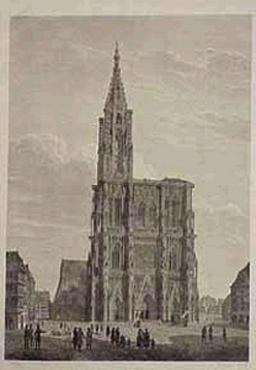
Classical and romantic style: From piano Variety to Uniformity
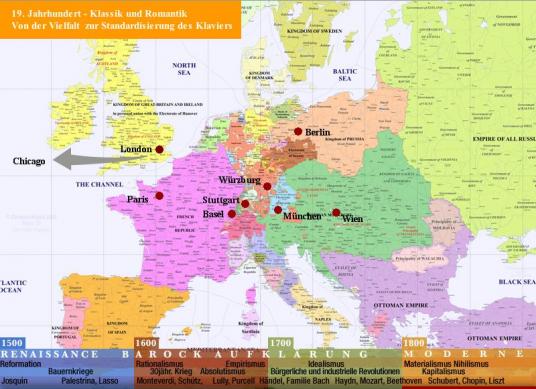
Basel
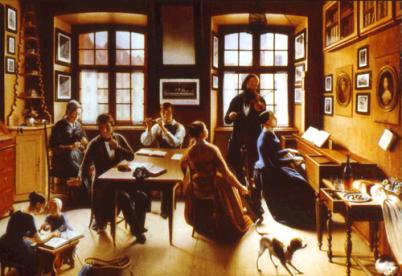
A 1849 family portrait by the Basel painter Sebastian Gutzwiler gathering three generations around the table. The piano (a typical square of that period) nearby, played by his wife, the painter himself behind her playing violin, their son on flute, their daughter (her back to viewer) on violoncello. Domestic music links the family. Only the grandparents and youngest children are busy with other activities, but by grandfather admonishing the children to silence music gets another significance as an activity demaning attention and admiration also by those only listening passively. Only the "unreasonable" dog remains untouched.
Berlin
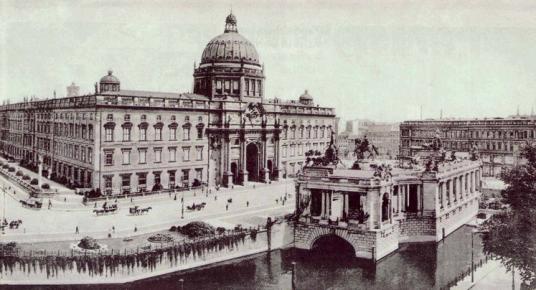
Prussia after the Napoleonic wars gained a leading role among the German states. The expansion of Prussia over the 18th and 19th centuries gives Berlin an important place among the European capitals.
But the Berlin musical life has not the high profile of
Paris, London or Vienna; The traditional institutions of courtly music culture like court orchestra, court opera would no longer attract leading musicians of the time like a C. Ph. E. Bach in the time of Frederic II. Representation of political importance would no longer care about music but about achievements in science, engineering and the military. This is also visible in the minor importance of Berlin piano manufacture, compared to other European capitals: The most significant product by Berlin piano producers is Schleip's "Lyra grand" truly showing decorative quality but certainly far from being a top model of piano building.
Chicago
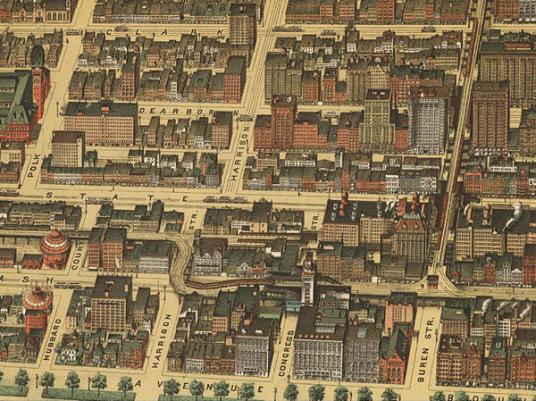
The first century of US independence is marked by an increase in population leading to rapid expansion of the major northern cities; New York, Chicago, Philadelphia or Minneapolis are growing much faster than the cities of the southern founding states of the USA, Virginia, Georgia or the Carolinas. Within a few decades they turn into centers of industries and economy for the whole country. In particular New York and Chicago, the one as major port at the east coast the other as the capital of food production, both attract considerable immigrant workforces as well as money. Chicago soon gains an important position in piano manufacture too by the decisive role of Jonas Chickering, who established on of the first modern style piano factories. Hi contribution to piano development - the cast iron frame - marks the "beginning of the end" of piano making as a handicraft since the production of such metal elements was beyond the abilities of a single craftsman.
London
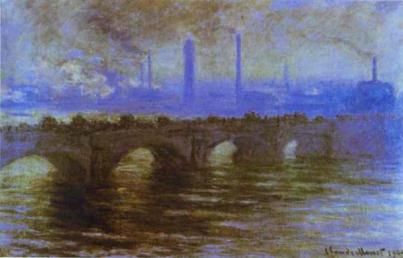
England offers a refuge during the era of the French revolution and beyond, establishing a position of rising world power resisting the French expansion under Napoleon. Cut off from the European continent during Napoleon's blockade English manufactures deliver their goods to growing overseas markets. After Napoleon's defeat at Waterloo the dominating role is further settled by colonial expansion. The leading position of English industry (manifested by steam engine, railway, modern steel production, textiles) can be achieved only after long delay by the other european nations.
Munich
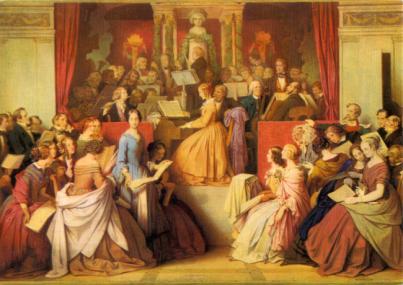
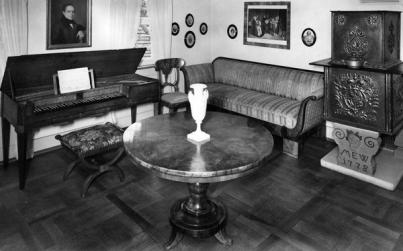
The political reshaping of central Europe after Napoleon and the congress of Vienna did not only shift political but also cultural relevances. Old Imperial cities are incorporated in new territorial states, ecclesiastical principalities vanished, new borderlines were drawn. The capital cities of newly formed states grow to centres of administration and industries, other cities losing their former importance drift into provincial decline.
The german mosaic of states, however, establish some smaller cultural centres besides the more and more powerful Prussia like the capitals of the kingdoms of Bavaria and Württemberg , Munich and Stuttgart. Some former capitals like the former ecclesiastical residences Würzburg or Mainz slowly lose their importance.
This is visible in the settlements of piano makers in this era. The distribution of Stein's pupils and imitators is spread rather evenly after 1810, with workshops eg in Stuttgart (Schiedmayer), Munich (Dulcken, Deiß), Würzburg (Pfister), Weimar (Schenck) or Mainz (Schott). Over later decades the trade focusses on new capitals. The provincial craftsmen turn irrelevant but even among those there happen to be some exceptional talents like the Schlimbach family in Königshofen im Grabfeld.
Paris
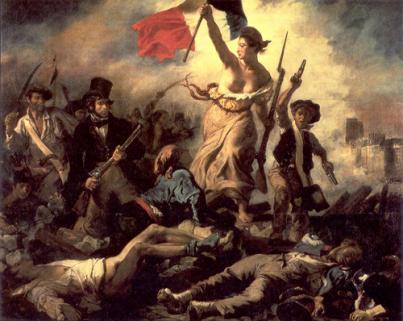
After revolution and Napoleonic rule the political, economic and cultural predominance of France declines. Internal instability like during the revolutions of 1830 and 1848 further destabilises the country. France is more and more isolated from the neighbouring countries and starts a rally with the UK to expand a colonial empire expecially in northern and western Africa. The capital Paris is remodelled by an extensive reshaping by Haussmann.
Musical concert life is primarily shaped by a few institutions like the Opera and the Conservatoire and the activities of the leading piano manufacturers Erard and Pleyel in steady competition with their own concert venues attracting the leading piano players to perform (on their own products). The number and quality of piano concerts in this era is maybe higher in Paris than anywhere else.
Vienna
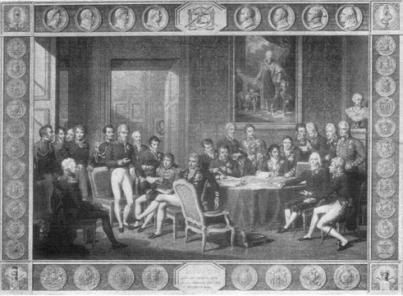
The metropolis of the Habsburg empire is one of centres of power in Europe: the congress of 1815 to create a stable post-Napoleonic peace order put an end to the centuries of rivalry of France and Austria. The Habsburg rule in the attempt to succeed the collapsing Ottoman empire soon evokes new conflicts. But the cultural significance of Vienna can be felt in all all parts of Austria and Hungary. Even in the periphery of the lands of the Habsburg crown one "little Vienna" after another grows, whether in Laibach
(Ljubljana), Triest, Prague, Lemberg (Lwiw) or Czernowitz.
Music in Vienna soon drifts to entertainment though, after the death of Beethoven (and Schubert). The public is no longer fascinated by the newest symphonies or piano sonatas but the newest viennese waltzes growing into the fashionable dance of the epoch after 1815 and adding worldwide fame to the leading composers like the Strauß family or Joseph Lanner.


